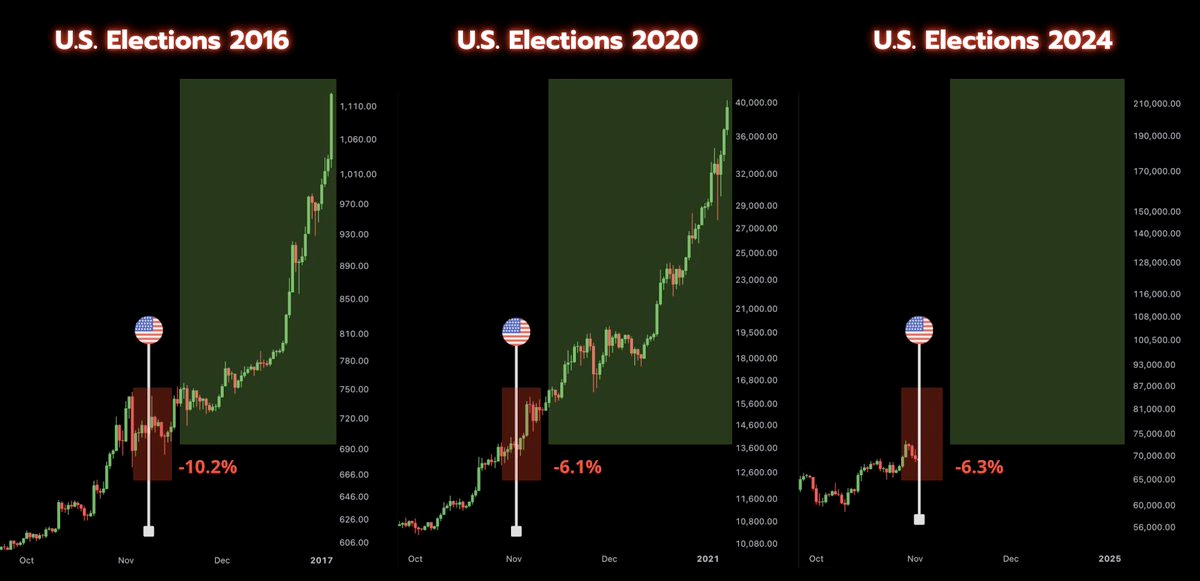The recent pre-election dip in Bitcoin aligns with past trends, suggesting a potential post-election rally similar to the ones seen in 2016 and 2020.
Today, Bitcoin declined to around $66,600, continuing the correction that gained momentum on Sunday, when the cryptocurrency briefly dropped to $68,000 after reaching $73,000 just days earlier. Following the latest dip, Bitcoin stabilized around $68,600. This still shows a 3.30% decline over the past seven days.
However, a glimmer of hope has emerged. Historical patterns suggest that Bitcoin tends to experience volatility leading up to U.S. elections, often followed by a post-election rally.
Scottie Pippen, a known Bitcoin bull and former NBA champion, observed that Bitcoin tends to decline before elections but typically rallies afterward. He shared an analysis of past election cycles that supports this. It highlighted how Bitcoin experienced significant recoveries in 2016 and 2020 after initial drops during election periods.
Bitcoin Pre- and Post-Election Trends
In 2016, Bitcoin’s price dropped by 10.2% before the election but rebounded sharply afterward, rising from $660 to over $1,110 in the following months.
Similarly, in 2020, a pre-election decline of 6.1% was followed by a post-election surge. Bitcoin’s price climbed from $13,000 to nearly $40,000 in the months after the election.
These past trends have fueled expectations for a potential post-election rally in 2024, especially as Bitcoin has already experienced a 6.3% dip in the lead-up to this year’s election.
Political Influence on Markets
An analysis by Santiment, a market intelligence platform, emphasized that cryptocurrency markets are highly sensitive to political developments. The platform noted traders frequently respond to policy signals, regulatory expectations, and candidate rhetoric, making elections a significant factor in short-term market movements.
Meanwhile, Santiment also pointed out that while past cycles have seen short-term bullish trends post-election, the assumption that elections inherently lead to positive outcomes for Bitcoin may be overstated. The market’s response will likely depend on the broader political and economic context.
Hence, the outcome of the 2024 U.S. presidential election is expected to influence market sentiment. Per the intelligence platform, whether Donald Trump or Kamala Harris wins, the focus will shift to how the next administration handles crypto regulations.
Santiment highlighted that the sector’s future could hinge on balancing innovative growth with regulatory oversight, setting the stage for how policies might shape the global digital asset landscape over the next four years.
Long-Term Forecasts Remain Optimistic
Despite immediate pre-election fluctuations, longer-term projections for Bitcoin remain optimistic. Bernstein analysts forecast that Bitcoin could reach $200,000 by the end of 2025. Gautam Chhugani, Bernstein’s Senior Crypto Analyst, reassured investors that the election’s outcome would not alter Bitcoin’s upward path.
Chhugani pointed to critical factors like rising U.S. debt, ongoing monetary challenges, and increased interest in spot Bitcoin exchange-traded funds as key drivers behind the predicted surge. He stressed that Bitcoin’s growth momentum is unlikely to reverse, indicating a broader shift that surpasses election outcomes.
DisClamier: This content is informational and should not be considered financial advice. The views expressed in this article may include the author's personal opinions and do not reflect The Crypto Basic opinion. Readers are encouraged to do thorough research before making any investment decisions. The Crypto Basic is not responsible for any financial losses.




